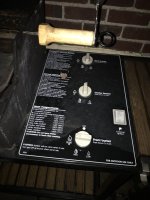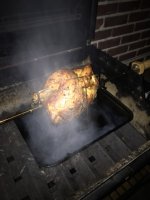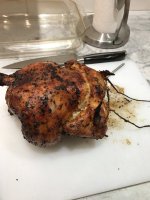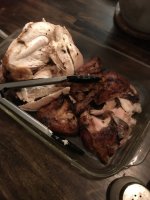THyde
TVWBB Guru
Thanks to many folks on the forum, the secrets to the best chicken I have ever cooked in my life are revealed here. I used a Genesis 2000 vintage late 90s to grill and the standard Weber 9890 rotisserie. You can get the same results with any gas Weber with burners in the East West orientation (the burners run side to side, not front to rear). I use a Meater thermometer because it measures the temperature inside the grill as well as the temperature inside the meat. The grill temp is also called "Ambient" in Meater jargon. Special thanks to Chuck-O for posting Susie's recipe for the rub from Hey Grill Hey.
In order to do this recipe, first you will need to get a whole young chicken. The ones I usually cook are no bigger than a football, but around that size or a little smaller.
1. Dry brine the chicken overnight. To do this, unwrap the bird and remove the giblets. Rinse with cool water, pat dry and drain any water out of the cavity. I like to clean the sink before I start and sit the bird with the cavity facing down to drain after I rinse it, then pat it dry right in the sink. Transfer the chicken to a large stainless mixing bowl and liberally apply salt to the skin. Rub the salt all over every square millimeter of the skin. Next, pretend you didn't just do that, and rub the salt all over the skin again. Leave the bird in the bowl, cover with saran wrap and refrigerate overnight. This will draw water but not fat out of the skin through the night.
2. The day you are ready to cook, be sure to allow about two hours' time for the first time you do this. You might get done early, but I have found my first time takes me longer.
3. Remove the grates from your grill and place a dry drip pan directly over the middle of the flavorizer bars.
4. Go back and make sure your dog did not start eating the uncooked chicken.
5. While you're there, it is time to make the dry rub. Mix the following in a bowl:
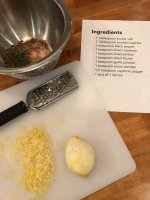
6. Combine the zest with the rest, and put it on the bird:
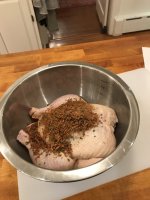
7. Rub the dry rub all over the chicken, between the leg and the body, over every square micrometer of the wings, make sure not to miss the crevasses.
8. Truss the bird. This involves tying the drum sticks and wings close to the body of the chicken so that they do not cook faster than the rest of the meat. There are lots of ways to do it, and I'm not "great" at it, but when it comes out like this I'm happy enough:
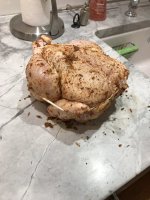
9. Spit the bird. Try to get it as balanced as you can on the spit so your rotisserie motor is not overworked while it cooks. My spit has a counterbalance. You can put the spit on the grill with the chicken and do not connect the motor yet. The heavy part of the chicken goes down. Put a counterbalance in the straight up position on the spit rod to make the weight more evenly distributed.
In order to do this recipe, first you will need to get a whole young chicken. The ones I usually cook are no bigger than a football, but around that size or a little smaller.
1. Dry brine the chicken overnight. To do this, unwrap the bird and remove the giblets. Rinse with cool water, pat dry and drain any water out of the cavity. I like to clean the sink before I start and sit the bird with the cavity facing down to drain after I rinse it, then pat it dry right in the sink. Transfer the chicken to a large stainless mixing bowl and liberally apply salt to the skin. Rub the salt all over every square millimeter of the skin. Next, pretend you didn't just do that, and rub the salt all over the skin again. Leave the bird in the bowl, cover with saran wrap and refrigerate overnight. This will draw water but not fat out of the skin through the night.
2. The day you are ready to cook, be sure to allow about two hours' time for the first time you do this. You might get done early, but I have found my first time takes me longer.
3. Remove the grates from your grill and place a dry drip pan directly over the middle of the flavorizer bars.
4. Go back and make sure your dog did not start eating the uncooked chicken.
5. While you're there, it is time to make the dry rub. Mix the following in a bowl:
Ingredients
- 1 Tablespoon kosher salt
- 1 Tablespoon smoked paprika
- 2 teaspoons black pepper
- 1 teaspoon dried rosemary
- 1 teaspoon dried parsley
- 1 teaspoon dried thyme
- 1 teaspoon garlic powder
- 1 teaspoon onion powder
- 1/2 teaspoon cayenne pepper
- 1 zest of 1 lemon

6. Combine the zest with the rest, and put it on the bird:

7. Rub the dry rub all over the chicken, between the leg and the body, over every square micrometer of the wings, make sure not to miss the crevasses.
8. Truss the bird. This involves tying the drum sticks and wings close to the body of the chicken so that they do not cook faster than the rest of the meat. There are lots of ways to do it, and I'm not "great" at it, but when it comes out like this I'm happy enough:

9. Spit the bird. Try to get it as balanced as you can on the spit so your rotisserie motor is not overworked while it cooks. My spit has a counterbalance. You can put the spit on the grill with the chicken and do not connect the motor yet. The heavy part of the chicken goes down. Put a counterbalance in the straight up position on the spit rod to make the weight more evenly distributed.

